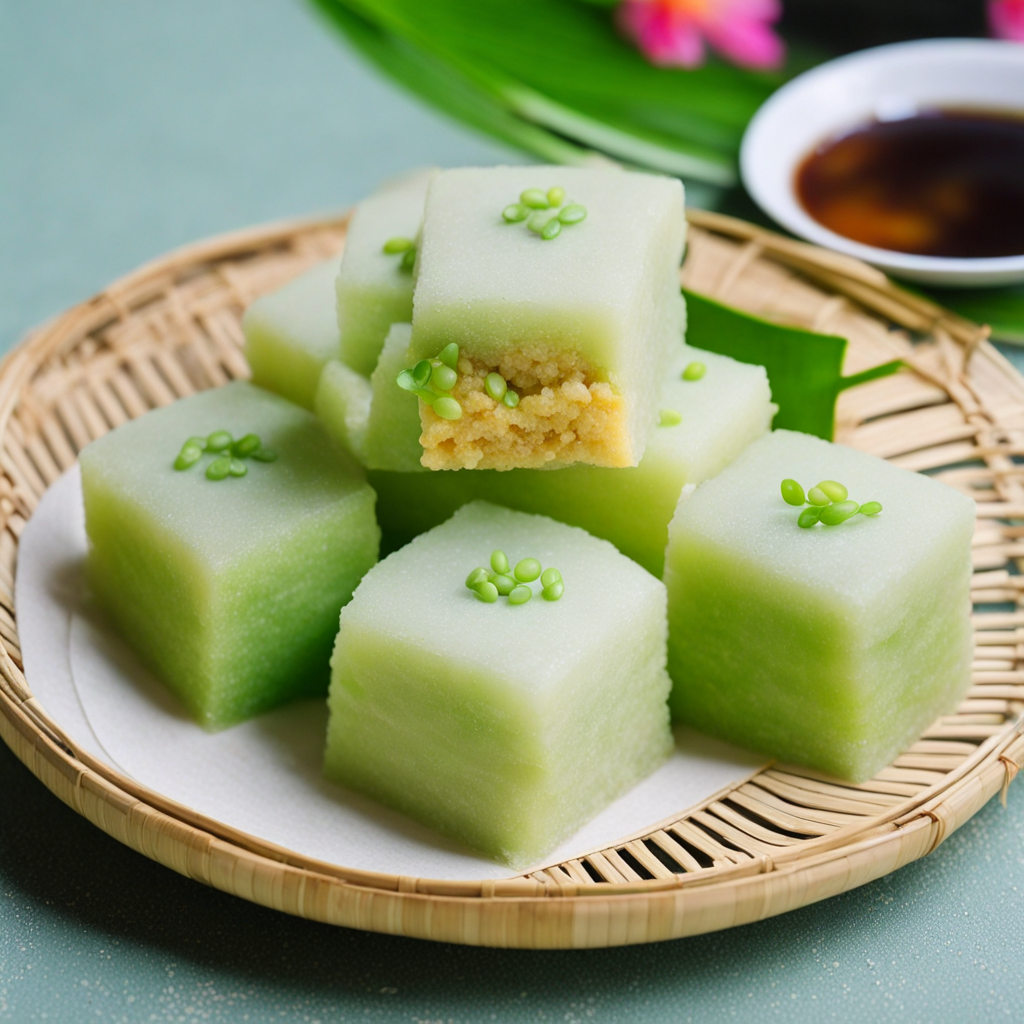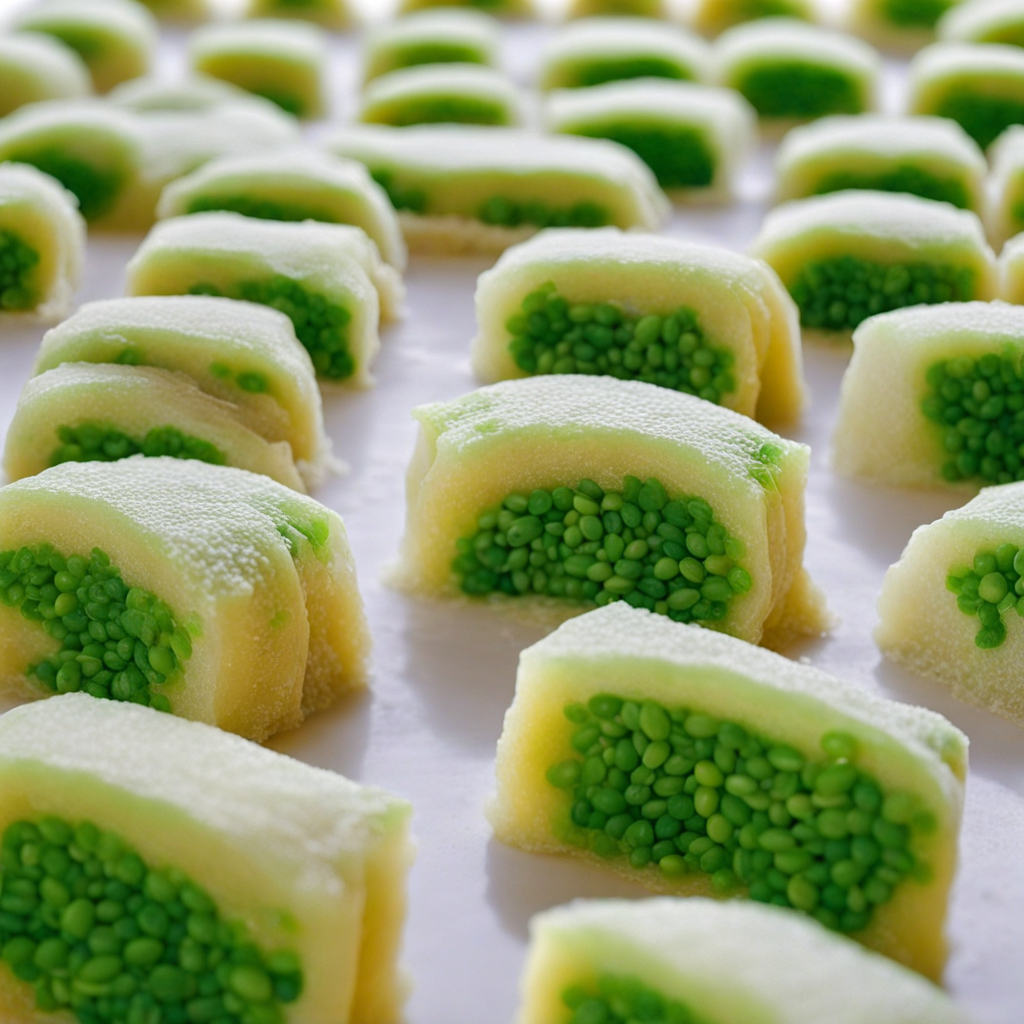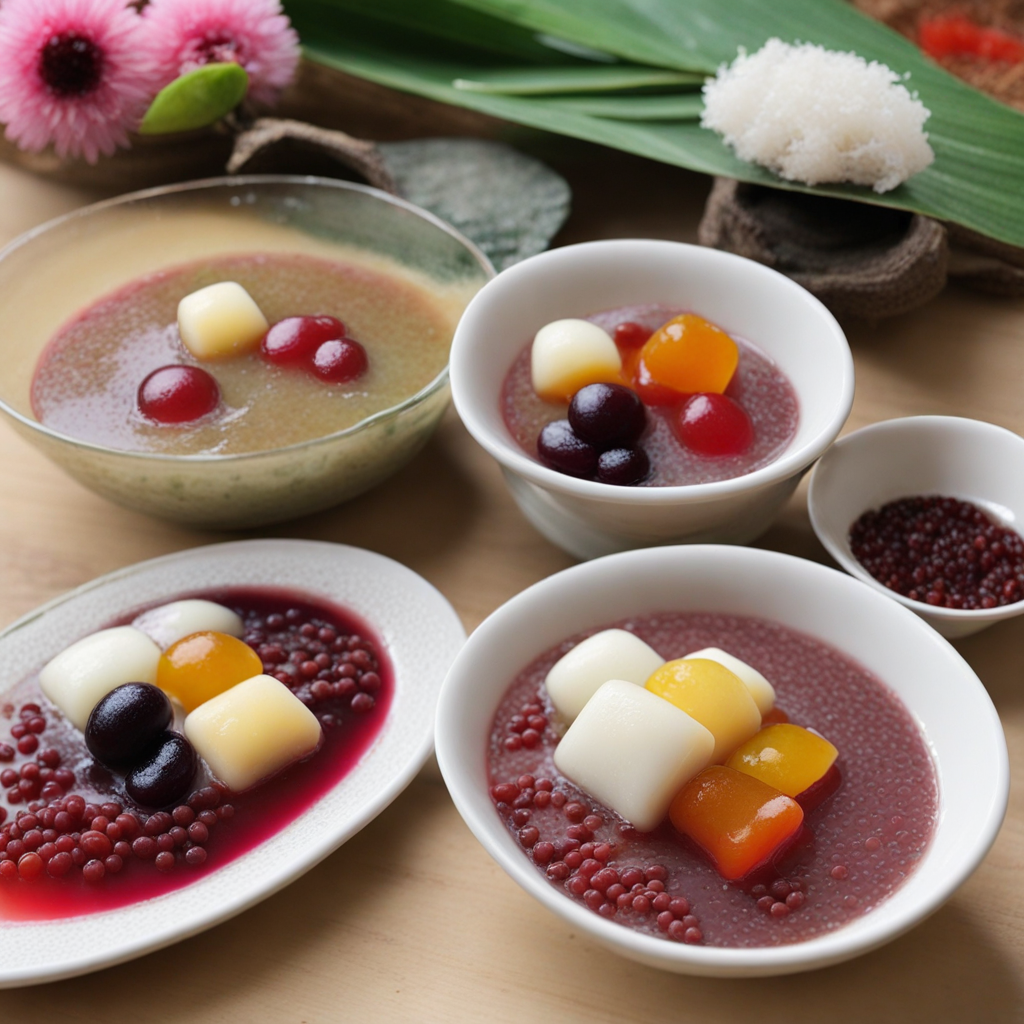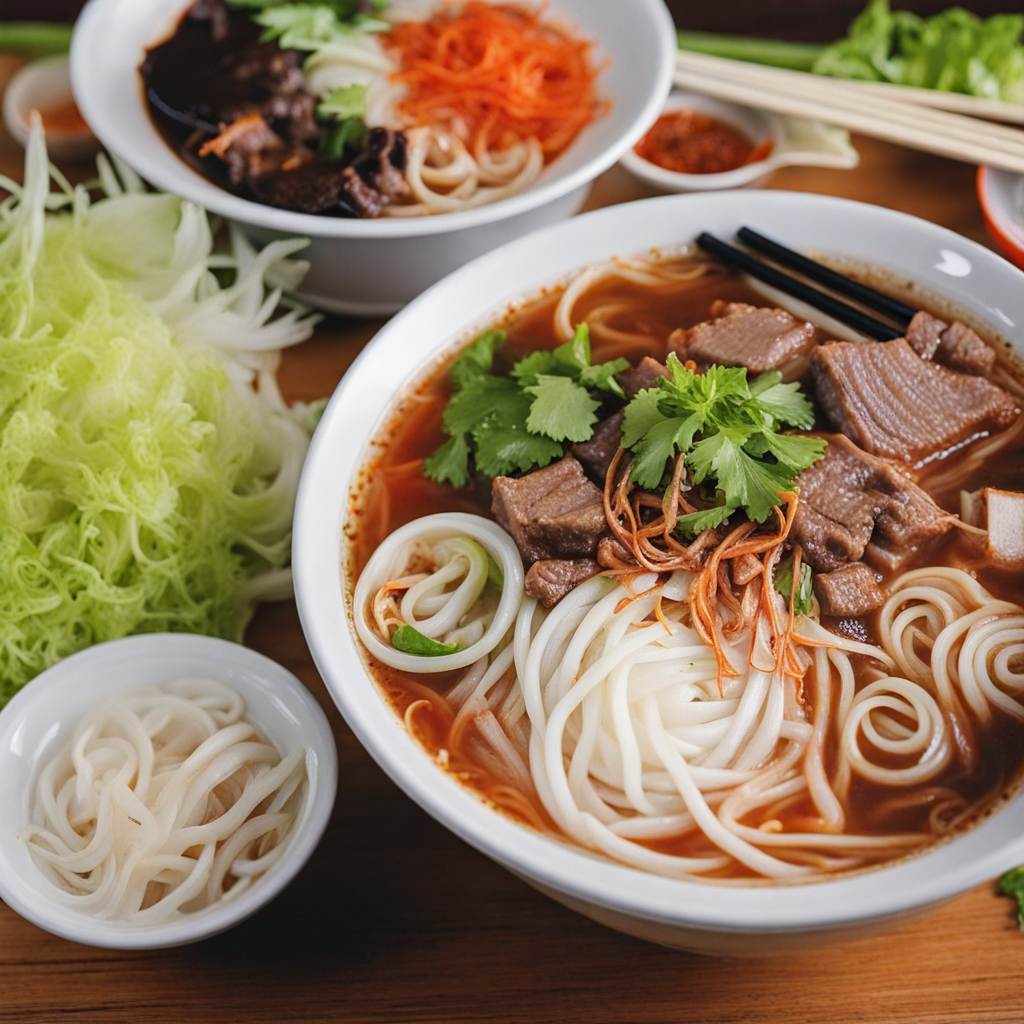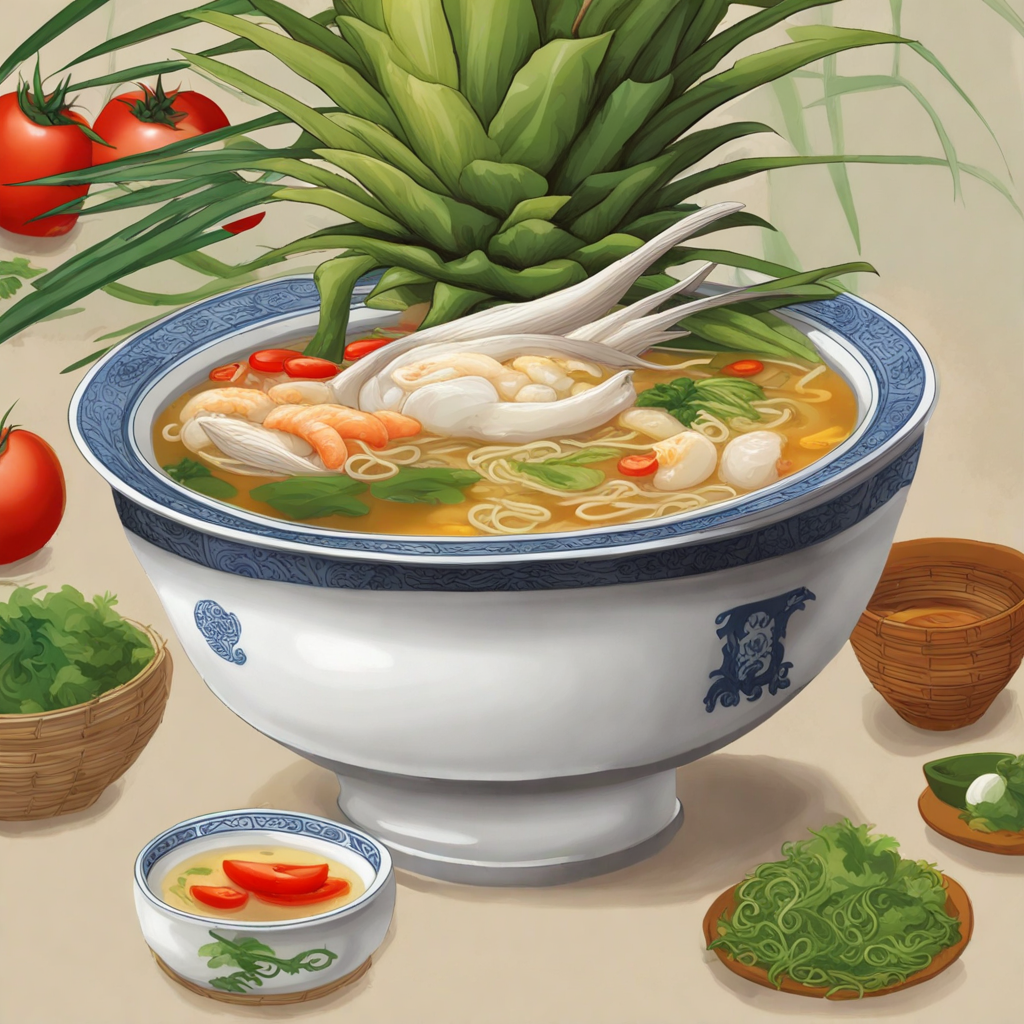Banh Da Lon
Banh Da Lon is a delightful Vietnamese dessert that captures the essence of the country's rich culinary heritage. This treat consists of colorful layers made from rice flour, tapioca flour, and coconut milk, providing a unique chewy texture that is both satisfying and intriguing. The layers are often infused with natural flavors such as pandan, which imparts a vibrant green color and a fragrant aroma, while the coconut milk lends a creamy richness that balances the sweetness of the dish. Each bite is a delightful experience, combining the soft, chewy layers with a slight hint of coconut and the aromatic notes of pandan, creating a symphony of flavors in your mouth. One of the most striking features of Banh Da Lon is its presentation. The dessert is typically served in rectangular or square pieces, showcasing its beautiful, vibrant layers that can range from deep green to pale white. The visual appeal is as important as the taste, inviting you to indulge in its colorful beauty. Often enjoyed with a drizzle of sweet syrup or a sprinkle of toasted sesame seeds, this dessert not only satisfies your sweet tooth but also provides a feast for the eyes, making it a popular choice for celebrations and gatherings. As you explore the taste of Banh Da Lon, you will discover the harmony of textures and flavors that Vietnamese desserts are known for. The combination of the chewy layers with the creamy coconut flavor and the aromatic pandan creates a unique culinary experience that is both refreshing and comforting. This dessert is perfect for those who appreciate the art of balance in food, where sweetness does not overpower but rather complements the other elements. Whether enjoyed as a casual snack or a special treat, Banh Da Lon promises to take your taste buds on a journey through the vibrant flavors of Vietnam.
How It Became This Dish
The Enigmatic Journey of Bánh Dẻo Lớn: A Culinary Artifact of Vietnam In the heart of Vietnam's rich culinary landscape lies a treat that is not only a feast for the senses but also a reflection of the country’s vibrant culture and history—Bánh Dẻo Lớn. This delightful dessert is a type of sticky rice cake characterized by its chewy, glutinous texture and subtle flavors. Traditionally filled with mung bean or sweetened coconut, it is often adorned with colorful, intricate designs that speak to the artistry of Vietnamese cuisine. The history of Bánh Dẻo Lớn is as layered as its ingredients, unfolding over centuries and embodying a tapestry of cultural influences and local traditions. Origins and Early Influences Bánh Dẻo Lớn, like many Vietnamese foods, can trace its origins back to the agricultural practices of the ancient Vietnamese people. Sticky rice, or "gạo nếp," is a staple in the diet of the Vietnamese and has been cultivated for thousands of years. The cultivation of rice in the Red River Delta, where the fertile land and favorable climate provided an ideal environment, laid the foundation for the development of various rice-based dishes, including Bánh Dẻo Lớn. The name "Bánh Dẻo" refers to the dessert's sticky and chewy texture, while "Lớn" translates to "large," indicating its size in comparison to other traditional rice cakes. The roots of Bánh Dẻo Lớn can be found in the broader category of "bánh," or cakes, which are integral to Vietnamese culture. The tradition of making rice cakes has been influenced by various ethnic groups in Vietnam, particularly the Kinh majority. Over time, these influences melded with indigenous practices, leading to the creation of unique regional variations. Cultural Significance Bánh Dẻo Lớn holds a special place in Vietnamese culture, particularly during significant festivals and celebrations. One of the most notable occasions for enjoying this treat is the Mid-Autumn Festival, known as "Tết Trung Thu." This festival is a time for family reunions and a celebration of the harvest, and it often involves the preparation of special foods, including mooncakes and sticky rice cakes. The presence of Bánh Dẻo Lớn during these festivities symbolizes unity and prosperity, as families gather to share meals and stories. In addition to its role in festivals, Bánh Dẻo Lớn is often served at weddings and other significant life events. It is considered a symbol of good luck and happiness, embodying the hope for a prosperous future for newlyweds or for those embarking on new ventures. The cake’s intricate designs, often featuring symbols of good fortune, add to its significance as a gift that conveys well-wishes and blessings. Development Over Time As Vietnam underwent various historical changes—from the influence of Chinese dynasties to the impact of French colonialism and the Vietnam War—so too did its culinary landscape. Bánh Dẻo Lớn adapted through these transitions, incorporating new ingredients and techniques while retaining its core identity. The introduction of sugar and other sweeteners during the French colonial period, for example, allowed for more elaborate flavor profiles and fillings, elevating the cake from a simple treat to a delicacy. In contemporary Vietnam, Bánh Dẻo Lớn continues to evolve, reflecting the changing tastes and preferences of modern society. With the rise of globalization, the cake has gained popularity beyond its traditional context, with many Vietnamese living abroad seeking a taste of home. Bakeries and dessert shops in major cities around the world have begun to offer this beloved treat, often experimenting with fusion flavors that blend traditional Vietnamese elements with international influences. Moreover, the growing interest in health and wellness has led to the rise of variations of Bánh Dẻo Lớn that use alternative ingredients, such as brown rice or natural sweeteners. This shift reflects a broader trend in Vietnamese cuisine, where traditional dishes are being reimagined to cater to contemporary dietary preferences without losing their cultural essence. Artistry in Craftsmanship One of the most captivating aspects of Bánh Dẻo Lớn is the artistry involved in its preparation. The process begins with soaking glutinous rice, which is then ground into a fine paste. This paste is kneaded and shaped into molds, often adorned with intricate patterns that reflect the maker’s creativity and skill. The fillings, usually made from mung beans or coconut, are prepared separately and added to the cakes before steaming. The act of making Bánh Dẻo Lớn is often a communal activity, with families and friends coming together to share stories and laughter while crafting these delicacies. This communal spirit is a testament to the cultural importance of food in Vietnamese society, where meals are not just about sustenance but also about connection and togetherness. Conclusion Bánh Dẻo Lớn is more than just a dessert; it is a cultural artifact that encapsulates the history, traditions, and artistry of Vietnam. From its origins in the fertile rice fields of the Red River Delta to its place in contemporary Vietnamese society, this sticky rice cake has navigated the complexities of history while remaining a beloved symbol of celebration and unity. As Vietnam continues to evolve and embrace modern influences, Bánh Dẻo Lớn stands resilient, serving as a reminder of the country’s rich culinary heritage. Whether enjoyed at family gatherings, festivals, or as a sweet indulgence, this enchanting dessert remains a cherished part of Vietnamese culture, inviting both locals and visitors alike to savor its flavors and the stories it carries. The journey of Bánh Dẻo Lớn is a testament to the enduring power of food as a medium of cultural expression, connection, and joy.
You may like
Discover local flavors from Vietnam


